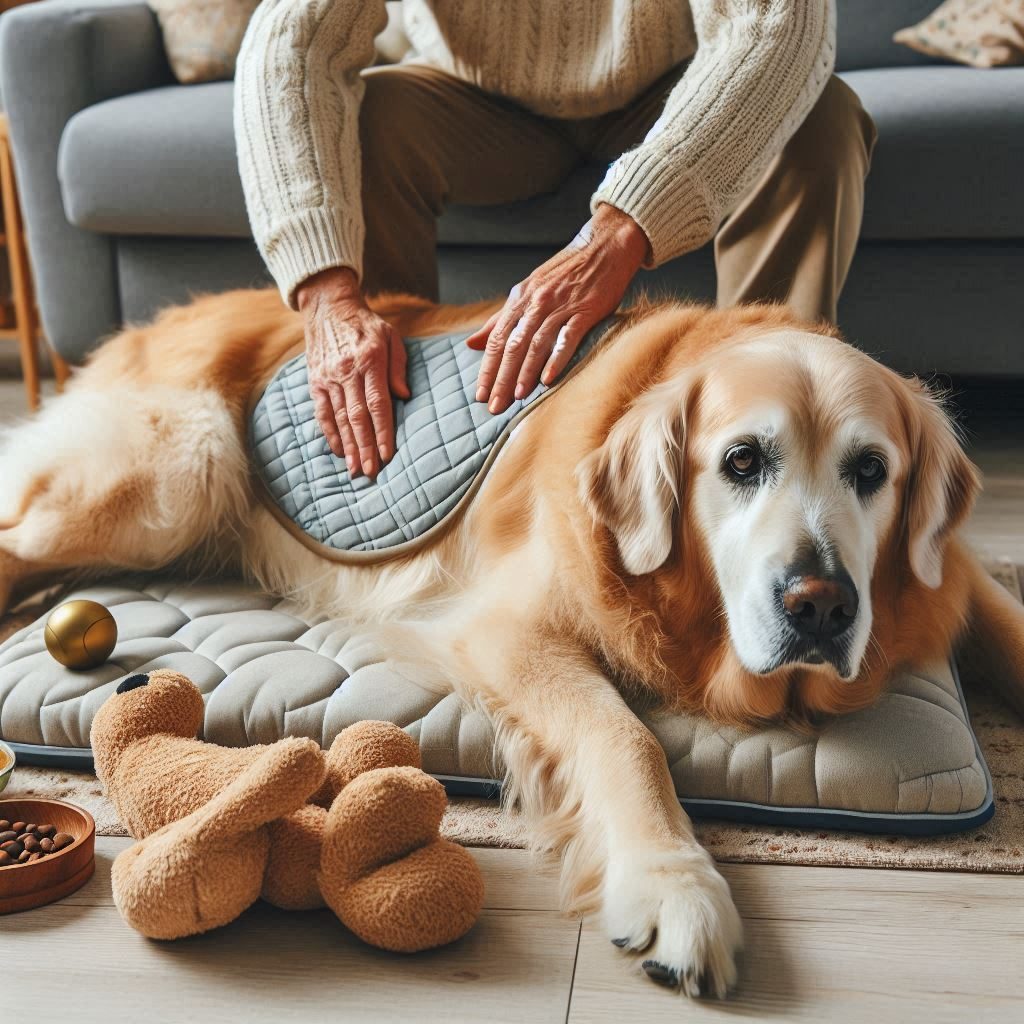Get your free Book Here

Understanding the Signs: Is Your Older Dog Suffering from Arthritis?
As dog lovers, we all treasure those precious moments spent with our furry companions. They greet us at the door as if we’ve just come back from a long voyage, wagging their tails with sheer joy. But with age comes wisdom—and, unfortunately, some physical hardships. One of the most prevalent struggles older dogs face is arthritis. Understanding its signs and symptoms is crucial for ensuring our pets continue to enjoy their golden years.
In this blog post, we will delve deep into the world of canine arthritis, unraveling its mysteries and shedding light on how we can support our beloved companions through their discomfort. We’ll explore the various types of arthritis, signs to watch for, how to diagnose it, and the best treatments available. Let’s embark on this journey together, as we strive to be the best pet parents possible!
1. What is Arthritis in Dogs?
Arthritis is an inflammatory condition affecting a dog’s joints, causing pain, swelling, or stiffness. Much like in humans, arthritis in dogs can vary in severity. The most common form is osteoarthritis, often referred to as degenerative joint disease. It usually develops over time, especially in older dogs or those with a history of joint injuries.
The condition leads to the breakdown of cartilage—the protective tissue at the ends of bones within joints. As the cartilage deteriorates, bones may start to rub against each other, creating pain and limiting mobility. Recognizing arthritis in dogs is vital because it allows us to manage their condition more effectively.

2. Signs and Symptoms of Arthritis in Older Dogs
Recognizing arthritis can be challenging, especially since dogs are masters at hiding their pain. However, there are distinct signs that can indicate your older dog is suffering from this condition.
-
- Reduced Activity Levels: If your dog is no longer as enthusiastic about walks or playtime, it could be due to discomfort in their joints.
-
- Limping or Favoring Limbs: Watch for any signs of limping or a reluctance to put weight on a specific leg.
-
- Difficulty Standing Up or Lying Down: Older dogs may struggle to transition from laying down to standing or vice versa.
-
- Stiffness After Rest: Dogs with arthritis often experience stiffness when getting up after resting, which tends to improve after some movement but may worsen as the day goes on.
-
- Behavior Changes: If your once-friendly pup seems irritable or withdrawn, they might be trying to cope with discomfort.
-
- Weight Gain: Reduced activity often leads to weight gain, putting even more strain on already aching joints.
-
- Excessive Grooming of Affected Joints: Dogs may lick or chew at painful joints to cope with discomfort, indicating distress.
-
- Changes in Toilet Habits: If your dog struggles to navigate stairs or get outside, they might have difficulty with regular bathroom breaks.
Always keep a keen eye on your furry friend. Observing these signs can lead to an early diagnosis, significantly improving your dog’s quality of life.
3. Diagnosis: How to Identify Arthritis
If you suspect your older dog may have arthritis, it’s crucial to consult your veterinarian. They will conduct a thorough examination, which may include:
-
- Physical Examination: Your vet will assess your dog’s joint movement and watch for signs of pain.
-
- X-rays: Radiographs can reveal joint abnormalities, such as changes in the joint space or bone spurs.
-
- Blood Tests: While blood tests can’t directly diagnose arthritis, they can help rule out other potential health issues.
-
- Joint Tap: In certain cases, your vet may recommend sampling the joint fluid for analysis to check for inflammation or infection.
Getting a proper diagnosis is essential for tailoring the best treatment plan for your furry friend.
4. Treatment Options for Dogs with Arthritis
Once diagnosed with arthritis, a variety of treatment options are available. As responsible pet owners, understanding these methods allows us to make informed decisions about our older dog’s care.
-
- Weight Management: Keeping your dog at a healthy weight can significantly reduce pressure on their joints. This may involve adjusting their diet and increasing gentle exercise.
-
- Medications: Your veterinarian may prescribe non-steroidal anti-inflammatory drugs (NSAIDs) to manage pain and inflammation. Newer medications may also be considered, depending on your dog’s specific needs.
-
- Supplements: Glucosamine and chondroitin sulfate are commonly recommended to help maintain joint health. While results may vary, many pet owners have noted improvements in their dogs with consistent use.
-
- Physical Therapy: Techniques such as hydrotherapy, acupuncture, and massage can help improve mobility and alleviate discomfort.
-
- Surgery: In extreme cases, surgical options may be necessary. Joint replacement or corrective surgery can provide relief for some dogs, although this is usually a last resort.
-
- Alternative Therapies: Don’t overlook the potential benefits of weight management systems, laser therapy, or even certain dietary changes that emphasize anti-inflammatory ingredients.
With the right approach tailored to your dog’s needs, it’s possible to enhance their quality of life drastically.
5. Understanding the Emotional Impact of Arthritis
Arthritis doesn’t just affect your dog physically; it can also take a toll on their emotional well-being. Dogs are perceptive creatures, and they can sense when they are experiencing discomfort. As they struggle to engage in their usual activities and routines, it can lead to feelings of frustration and depression.
Providing emotional support is just as crucial as addressing their physical needs. Show your dog extra love and understanding during this challenging time. Engage in gentle activities that don’t strain their joints, such as interactive games or puzzle toys, to help keep their spirits high.
6. Creating a Comfortable Environment
As pet parents, we can do a lot to make our older dogs with arthritis feel more comfortable in their environment. Here are some tips to help ease their daily struggles:
-
- Orthopedic Dog Beds: Invest in a good-quality orthopedic dog bed that provides proper support for aching joints.
-
- Non-Slip Flooring: If your dog is struggling to walk on slippery surfaces, consider adding non-slip rugs or mats to help them maintain their footing.
-
- Ramps or Steps: Instead of letting your dog jump onto furniture or into the car, consider using ramps or pet stairs to assist them.
-
- Bedding Areas: Create various comfortable spaces for your dog to rest throughout the house, so they have easy access to their favorite spots without excessive movement.
-
- Temperature Control: Keep your home at a comfortable temperature, as cold weather can exacerbate arthritis symptoms. A dog coat can also offer additional warmth when outside.
Creating a supportive environment can contribute significantly to your dog’s quality of life.
7. Preventative Measures for Joint Health
While we can’t always prevent arthritis, there are steps we can take to minimize the risk.
-
- Regular Exercise: Keeping your dog active helps maintain a healthy weight and promotes strong muscles around the joints. Focus on low-impact activities, such as swimming or short walks, to avoid straining their joints.
-
- Balanced Diet: A nutritious diet rich in anti-inflammatory ingredients can help maintain joint health. Consult your veterinarian for recommendations on quality dog food tailored to your pet’s needs.
-
- Routine Vet Checkups: Regular checkups can catch signs of arthritis early and establish a proactive management plan.
-
- Joint Supplements: Starting joint supplements at a younger age can help support long-term joint health and delay the onset of arthritis.
Fostering a healthy lifestyle can go a long way in ensuring your furry friend enjoys a long, pain-free life.
8. Seeking Veterinary Help: When to Worry
As a dog lover, one of the most challenging moments we face is knowing when to seek help for our pets. If you’re unsure whether your dog is experiencing arthritis or any other common condition, here’s a simple rule of thumb: if your gut tells you something isn’t right, don’t hesitate to consult your veterinarian.
Some specific indicators worth immediate attention include:
-
- Sudden Limping or Change in Mobility: If your dog suddenly starts limping or struggles to get up, they may be in significant pain.
-
- Persistent Signs: Lingering signs, even if they aren’t severe, shouldn’t go ignored. Frequent checking in with your vet can prevent conditions from worsening.
-
- Dramatic Behavior Changes: If your dog becomes increasingly withdrawn or irritable, it may be an issue that requires professional assistance.
We, as dog lovers, have the responsibility to advocate for our pets, ensuring they receive the care and attention they need.
Conclusion
Our furry companions give us unconditional love, loyalty, and countless cherished memories. It can be heartbreaking to see them struggle as they age, and arthritis can significantly impact their quality of life. As dog lovers, we owe it to our furry friends to understand their needs, recognize the signs of arthritis, and act promptly.
By creating supportive environments, incorporating preventative measures, and relying on veterinary guidance, we can ensure our older dogs live their remaining years in comfort and happiness. We share this journey with them, and as such, it is our privilege—and responsibility—to care for them throughout their lives.
FAQs
Q1: Can arthritis in dogs be cured?
A1: Unfortunately, arthritis cannot be cured, but it can be managed effectively with the right combination of medication, lifestyle changes, and supportive measures.
Q2: What age do dogs typically develop arthritis?
A2: Though some dogs may develop arthritis as young as five years old, it’s more commonly diagnosed in older dogs, often around eight years and older.
Q3: Is arthritis painful for dogs?
A3: Yes, arthritis can be painful for dogs. They may hide their discomfort, but they can experience significant levels of pain and reduced mobility.
Q4: Can diet influence my dog’s arthritis?
A4: Yes! A balanced diet that’s rich in Omega-3 fatty acids and anti-inflammatory ingredients can help manage weight and promote joint health.
Q5: Should I exercise my dog if they have arthritis?
A5: Absolutely! Gentle, low-impact exercises can help maintain mobility and muscle strength. Always consult your veterinarian to tailor an exercise plan that suits your dog’s abilities.
Q6: Are there any natural remedies for dog arthritis?
A6: Some dog owners have found success with supplements like turmeric or CBD oil. Discuss these options with your vet before starting any new treatment.
Q7: How can I tell if my dog’s medication is working?
A7: Look for signs of increased mobility, less limping, and general eagerness to engage in activities they previously enjoyed. Regular vet check-ups can help track their progress.
Q8: Can weight loss improve my dog’s arthritis symptoms?
A8: Yes, weight loss can reduce strain on your dog’s joints, alleviating pain and improving their overall quality of life.
Unlock the Secrets to a Well-Behaved Dog! 🐾 Tired of your pup’s bad habits? Discover how to transform your unruly dog into a loving companion with our FREE Dog Training Mini Course! Learn essential commands, potty training tips, and effective techniques to eliminate unwanted behaviors in just days. Don’t miss out—sign up now and start your journey to a happier, obedient dog! Join Here! (https://bit.ly/3RJak0a)
Disclaimer: I may earn a commission from qualifying purchases as an affiliate. Please note that I only recommend products I believe will provide value to my readers.







